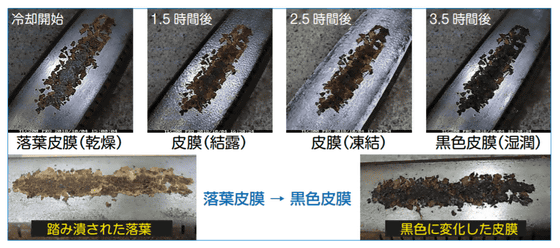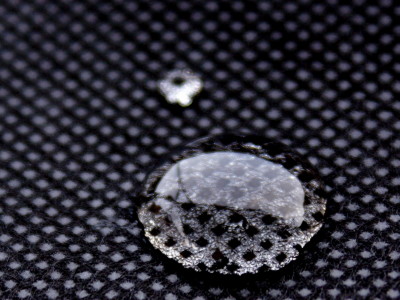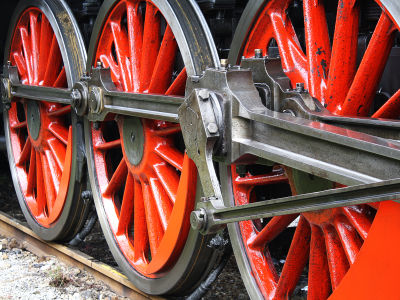Why do 'fallen leaves' on railroad tracks cause train wheels to slip?

Train delays are a headache for commuters, but 'falling leaves' on railroad tracks can cause trains to delay by causing wheels to slip or slide. Researchers have pointed out that the phenomenon in which fallen leaves cause wheels to slip and slide is due to the '
To elucidate the wheel slipping/sliding mechanism caused by leaf fall
(PDF file) http://bunken.rtri.or.jp/doc/fileDown.jsp?RairacID=0004007161
The composition and friction-reducing properties of leaf layers | Proceedings of the Royal Society A: Mathematical, Physical and Engineering Sciences
https://royalsocietypublishing.org/doi/full/10.1098/rspa.2020.0057
Dry ice could prevent rail delays caused by'leaves on the line'-Latest-News-The University of Sheffield
https://www.sheffield.ac.uk/news/nr/leaves-on-the-line-railways-solutions-delays-dry-ice-how-to-remove-1.867967
Scientists find out why leaves on the track causes travel chaos | Transport | The Guardian
https://www.theguardian.com/uk-news/2020/jul/29/scientists-find-out-why-leaves-on-the-track-causes-travel-chaos
According to a paper published by the research team of the Railway Technical Research Institute , a public interest incorporated foundation under the umbrella of JR, which researches and develops railroad technology in 2019, ``Understanding the wheel idling/sliding mechanism by falling leaves'' It is said that the phenomenon that causes the wheel to slip/slide is caused by the 'black film' formed when tannin contained in the fallen leaves reacts with iron, which is a component of the rail.
The research team conducted a simulated test using the following test tracks and simulated wheels in order to confirm how the fallen leaves trampled on the wheels changed to a black film when passing the train.

We distributed 0.4 g of cut fallen leaves on the test track, pulled it 64 times with simulated wheels, and then cooled it, reproducing the actual situation that 'fallen leaves fallen in the daytime are cooled at night when there is no operation' .. As a result, it was discovered that wet conditions were necessary for the formation of the black film.

In addition, the research team is also conducting an experiment on how much the wheel slides using a black film formed under wet conditions. According to this experiment, a dry black film does not cause vehicle slippage, but a wet black film frequently causes wheel slippage. It was shown that the wet condition is greatly involved not only in the formation of the black film but also in the slip of the wheel.

A new paper published in July 2020 by a research team at the Department of Mechanical Engineering, University of Sheffield , proves that tannin contained in fallen leaves and iron chloride contained in railroad tracks are the factors that form a black film. A research team at the university added chlorinated sycamore leaves containing tannin to water to create an extract, and added iron chloride, which is equivalent to the iron released from the tracks. As a result, it was confirmed that a black film that could be seen on the track was formed. Furthermore, when this black film was tested using a simulated wheel, it was confirmed that friction was significantly reduced. In addition, when the same experiment was performed using leaves that did not contain tannin, a black film was not formed and friction did not decrease so much.
In the UK, 50 million leaves are falling on the railroads every autumn, and it is estimated that the damage caused by wheel slipping/sliding reaches 345 million pounds (about 49 billion yen) per year. 'The tannins, not the leaves themselves, are responsible for the low frictional forces,' the research team at the University of Sheffield said. 'I hope this study will lead to the discovery of scientific treatments that hinder the formation of black coatings.' I comment.
Related Posts:







